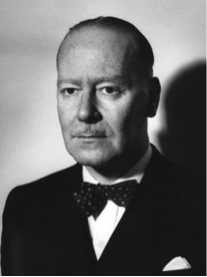 Kenneth Adolf Slessor was born in Orange, New South Wales in 1901 to parents of German-Jewish origin. The family name was originally Schloesser and they moved to Sydney when Kenneth was two years old. The young boy loved to read and was encouraged by his parents to do so, along with teaching him to love music and appreciate good food. In short, they hoped to foster in him some of the European sophisticated way of life that they had left behind when they emigrated. Kenneth’s father changed their name to Slessor in 1914, not wishing to risk being persecuted because of their German ancestry.
Kenneth Adolf Slessor was born in Orange, New South Wales in 1901 to parents of German-Jewish origin. The family name was originally Schloesser and they moved to Sydney when Kenneth was two years old. The young boy loved to read and was encouraged by his parents to do so, along with teaching him to love music and appreciate good food. In short, they hoped to foster in him some of the European sophisticated way of life that they had left behind when they emigrated. Kenneth’s father changed their name to Slessor in 1914, not wishing to risk being persecuted because of their German ancestry.
The young Kenneth wrote poems and edited the school magazine. By the age of 17 he had already had two pieces of work published and this brought him to the attention of the Australian newspapers. One of them, The Sun, took him on as a cadet journalist following his graduation with a first class honours degree in English. It was soon apparent that Ken was a talented and stylish writer with a keen interest in satirical writing. He was soon to demonstrate an interest in poetic imagery when he rewrote previously translated Chinese work. In between his journalistic and poetic efforts there was time for romance and, at the age of 21, he married Noëla, a wife to whom he was devoted throughout their childless marriage.
Slessor was dismissive of the so-called “bush balladist” poets that Australia had seen up to the early years of the 20th century. It took him a long time but his writings eventually introduced the country to a modern style of poetry and, with the help of Jack Lindsay and Frank C. Johnson, he produced a publication called Vision: a Literary Quarterly. Although this only lasted a short time (four issues) the promotion of Nietzschean ideas along with open discussions of sexuality and aesthetics were now very much on the agenda. The three followed this up with an equally controversial piece of work in 1923 – Poetry in Australia.
Journalism remained a real driving force for Slessor, contributing satirical verse to The Herald in Melbourne sub-editing Punch magazine. He still had time to produce an illustrated book of poetry in 1924 called Thief of the Moon. Next up was a long, settled period writing for Smith’s Weekly and he thoroughly enjoyed the experience of working for a publication that was never afraid to shock with its vulgarity. He eventually became editor and stayed until 1940. His output of poetry was considerable at this time, some being published in the magazine and some came out in book form. It was all fairly light verse including Cuckooz Contrey, Darlinghurst Nights and, for children, a collection called Funny Farmyard in 1933.
On a much more serious note, a death by drowning in Sydney harbour in 1927 inspired Slessor to write the elegy Five Bells, and this, more than anything else, placed him amongst Australia’s top ranking poets. Here are a few lines from this haunting poem:

He served during WWII as a war correspondent and saw plenty of action but upset the establishment too often with his style of writing. The post war years and the 1950s and 1960s saw him busy editing collections of Australian poems by other writers and writing the occasional one himself but his output was now much less. He preferred to concentrate on his distinguished journalistic career.
In 1971 he suffered a myocardial infarction and died suddenly. Like many poets throughout the ages his work was appreciated more after his death, and he is still regarded as one of Australia’s finest poets.

